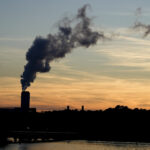

The Environmental Protection Agency published a final rule Tuesday cracking down on toxic air pollution from chemical and plastics plants, seeking to reduce exposure to two cancer-linked chemical compounds, ethylene oxide and chloroprene, while also giving plant owners slightly more time to comply.
Once implemented, EPA officials said, the final rule will achieve a nearly 80% reduction in emissions from ethylene oxide and chloroprene, two toxic compounds linked to certain types of cancers, including lymphoma, leukemia, breast cancer, and liver cancer.
In total, officials said, the rule will slash 6,200 tons of toxic air pollution annually from U.S. chemical and plastics plants, reducing the number of people at elevated cancer risk from the air toxics by roughly 96%.
The EPA’s rule also extends certain reporting requirements for facilities that produce, store, or emit the toxins benzene, 1,3-butadiene, ethylene dichloride, and vinyl chloride, in addition to ethylene oxide and chloroprene.
Facilities that handle these chemicals will now be required to measure and share data on emissions from these six contaminants, measured at their parameters, so-called fence-line emissions. The EPA said it will monitor and share the data publicly on its site in order to incentivize plants to proactively find and fix any leaks that could cause public harm.
Senior administration officials estimate that roughly 200 plants will be affected by the final rule, primarily concentrated in Louisiana, Texas, the Ohio River Valley, and the Upper South.
The rule does extend the compliance time for plants to meet fence-line emissions monitoring requirements, a change that officials said was the result of “tens of thousands of comments” it had received from stakeholders in response to its proposed rule and the time needed for plants to make the changes.
Officials maintained that the new rule delivers on the Biden administration’s long-standing public health and environmental justice commitments, including the $60 billion fund created by the 2022 Democratic Inflation Reduction Act aimed at helping poorer towns and minorities combat pollution.
Biden officials also noted it delivers on cancer-fighting commitments under the “Cancer Moonshot” initiative, first announced by then-Vice President Joe Biden in 2016.
In announcing the actions, EPA Administrator Michael Regan recounted the trips he made in recent years to “Cancer Alley,” the 85-mile stretch of industrial land in Louisiana that earned the nickname due to high air pollution rates from nearby petrochemical plants and a cancer rate at least 50 times as high as the national average.
“Nearly every person I spoke to [there] knew someone who suffered from an illness connected to pollution from the air they breathed,” Regan recounted of his trips to the Louisiana parishes. “I promised to listen to folks that were suffering from this pollution and take action as an agency to protect them. I promised to prioritize the health and safety of this community and others’ lives that have been historically overburdened by air pollution.”
“Today,” Regan said, “EPA is delivering on that promise.”
The EPA came under intense criticism in June 2022 after it abruptly dropped a more than 12-month federal investigation into possible Title VI violations in Louisiana, in particular whether state officials had discriminated against black residents in their oversight of industrial pollution levels in the state.
Asked Monday about EPA’s decision to drop the investigation, Regan told reporters that the new rule is unrelated to its Louisiana inquiry, an investigation that had emanated from complaints that the state had violated Title VI of the Civil Rights Act.
CLICK HERE TO READ MORE FROM THE WASHINGTON EXAMINER
The new rule will allow EPA to “ensure we protect all of these communities” threatened by toxic pollutants, Regan said.
“Not just those in Cancer Alley but communities in Texas and Puerto Rico and other areas that are threatened by these hazardous toxic pollutants,” he added.







